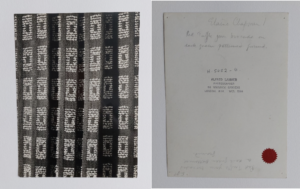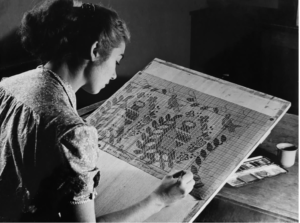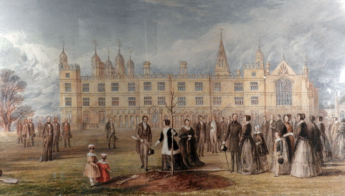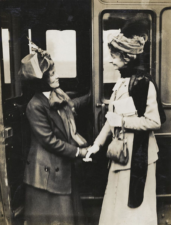When you hear the term ‘Mid-century design’ it may conjure images of Le Corbusier’s Brutalist architecture, Marcel Breuer’s ‘Wassily’ chair, or George Nelson’s clocks, but why do we often hear less about the women of this period?
In stark comparison to the eighteenth-century where women students and practitioners were not permitted entry into art and design institutions, post-war Britain saw a surge in the success of women artists with the emergence of well-respected creatives like Ray Eames and Lucienne Day.
Whilst access to the industry was improving, societal expectations and patriarchal prejudice continued to be obstacles to success. My grandmother’s story exemplifies this.
Anyone who would have met my grandmother, Elaine, towards the end of her life, would have detailed her dedication to homemaking, her love of Nick Knowles from BBC’s DIY SOS, and the remnants of a cockney cackle when you made her laugh. However, it was only after she passed away at the start of 2020 that my family realised the depth of her talent in textile design.
When sorting through her possessions in leafy Ledbury, Herefordshire, we unearthed a photo album that chronicled her success in mid-century design.
Born in 1924, Elaine ‘Bunty’ Chapman was the much loved only child to Lilian and Edgar. Having been victim to the mustard gas of the trenches in the First World War, Edgar was absent for large periods of Elaine’s childhood, taking residence in various convalescent homes in the hope of recovery. As a result, she spent most of her childhood exclusively with the female members of her family, and from there she was passed down all the traditional needlepoint and sewing techniques from the myriad of women that surrounded her.
These skills have continued to grow in my family with many of us making our own clothes, embroidering, and quilting homewares, and more recently producing surgical gowns and masks during the PPE shortage at the start of the Coronavirus Pandemic.
We had always known of Elaine’s career prior to starting a family with my grandfather (she would often regale her dementia nurses with tales of when she was at ‘The Central’), but we were more au fait with his work as a lifelong academic in ceramics – Dr Donald Hall.
The story goes that Elaine, after marrying Donald, was ‘let go’ of her then position as a tutor in woven textiles (at what was then The Central School of Arts & Crafts) when she became pregnant in the late 1950s. This proved to be the catalyst for the end of her career in textiles. She never expressed any regret of these circumstances, and was a wonderful mother and grandmother, but I cannot help but imagine how her career may have progressed in comparison to her male counterparts of the time (she worked alongside famed designers and artists Terence Conran and Eduardo Paolozzi).
Festival of Britain (1951)
The Festival of Britain was a series of events and exhibitions to show ‘The British contribution to civilization past, present and future, in the arts, in science and technology and in industrial design’ (Atkinson, 2012). It took place in 1951 to mark the centenary of the Great Exhibition of 1851.
The festival was a showcase of the finest of mid-century modernist design, and one of the exhibitors was my grandmother. Whilst we cannot be certain of the exact work displayed, we unearthed the original commission note from the Festival of Britain office.

“Material as selected by Mr Hilton Wright at £2-0-0 per yard.
(Special hand woven upholstery textile)”
Mentioned in this note is Hugh Casson who would act as ‘Inspecting Officer’. Sir Hugh Casson; as he would later become, was Director of Architecture for the festival and later served as President of the Royal Academy.
Victoria & Albert Museum
One major discovery made after she died, was that one of her samples of woven fabric is held in the archives at the Victoria & Albert Museum. Unfortunately, Elaine had not been aware of this, and it would have no doubt served as validation of the success and prestige of her career however short it had been.
Upon closer inspection, the sample featured on the V&A website looked familiar and we were able to match it up with one of the photos in her album:

“Red truffle jam brocade on a dark green patterned ground”
Looking through the remnants of her career in boxes and albums has left me with a number of questions.
- If she were starting her career in today’s world, how far would her career have taken her?
- Would Conran and Paolozzi have had the esteemed careers they had if they had been women?
I intend to look further into Elaine’s work and look forward to uncovering more. I will certainly see the embroidered Christmas stocking she made me in a different light, now that I know it was made by the same hands that have work in the V&A and exhibited in the Festival of Britain.
Image of Elaine Joan Hall (nee Chapman) author’s own.
References
Sellers, L. (2021) Women Design: Pioneers from the twentieth century to today. 1st edn. London: Francis Lincoln
Atkinson, A. and Banham, M. (2012) The Festival of Britain: A Land and Its People. 1st edn. London: I.B.Tauris & Co Ltd
Biography
Esther Dobson is a Research & Knowledge Exchange Facilitator at the University of Worcester. She has a keen interest in the social history of textiles from the 20th century, and as well as enjoying working with textiles in her spare time, is currently pursuing postgraduate opportunities in History.


